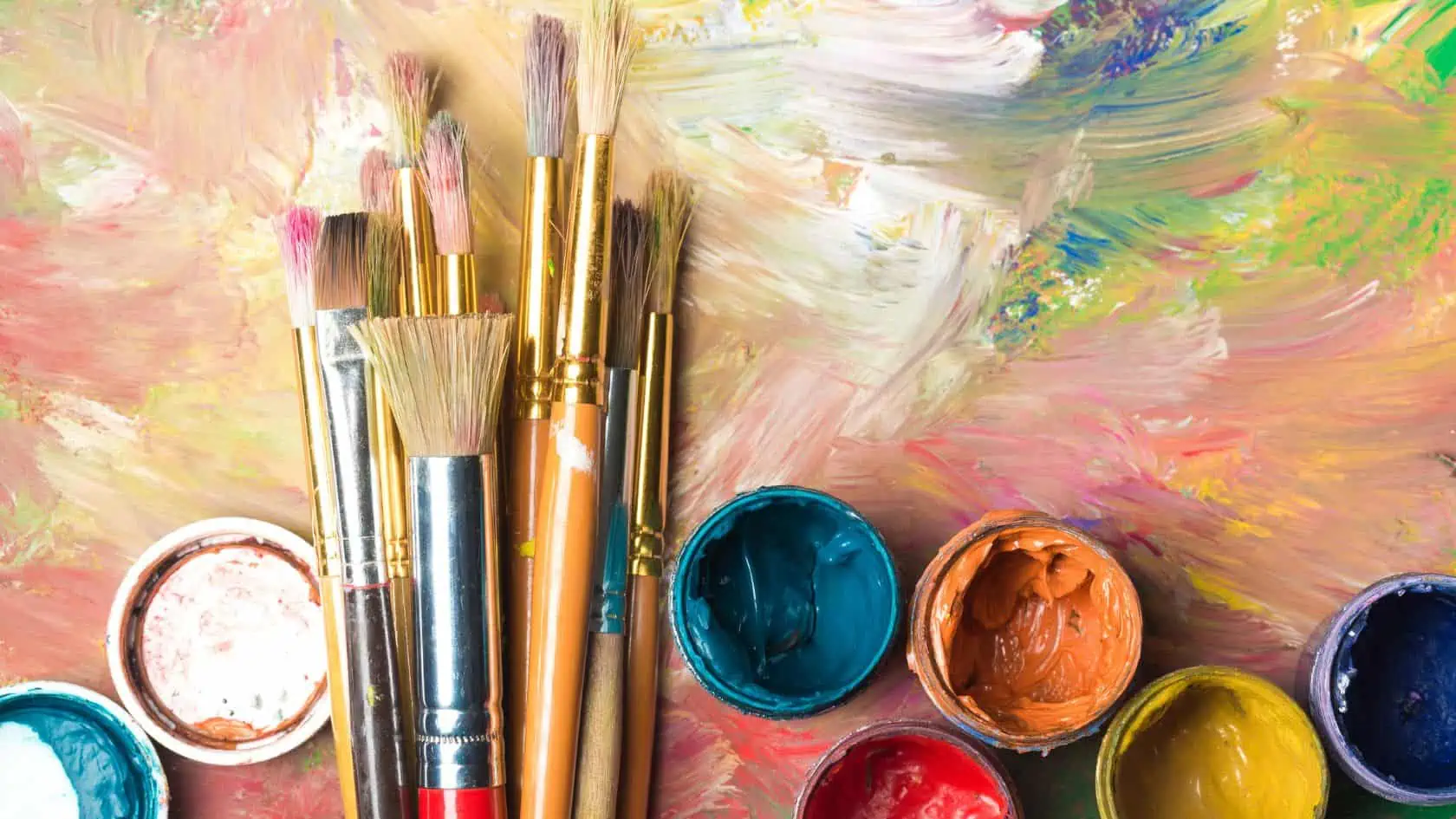30 Most Famous Artists of All Time
Do you like art and want to know more about the most famous artists of all time? Here’s the list you’ve been waiting for.
The artists presented in this article all share the usual stamps of fame: inclusion in global rosters as art masters with critically acclaimed reputations, being routinely taught in schools and frequently referenced in pop culture and having easily recognizable iconic masterpieces.
Their lives and careers will bear out that they deserve to be esteemed as the leading lights in art. Check out this list of the most famous artists to see if your favorite made the cut.
30 Most Famous Artists of All Time
Artists are often revered as those bringing creativity and inspiration to the world. Famous artists, in particular, have captured the essence of our lives, imaginations, and emotions.
From color palette masters like Monet, Da Vinci, and Van Gogh to notable sculptors and architects like Michelangelo and Gaudi, these famous artists brought a new perspective to art and the cultural revolution.
1. Leonardo Da Vinci (1452 – 1519)
Leonardo da Vinci is widely acknowledged as the most famous and influential artist of the Renaissance period and one of the most renowned artists. His most iconic work, the “Mona Lisa,” was painted during his stay in Florence between 1503 and 1519 and has since been kept in the Louvre Museum in Paris. While it’s one of the most well-known art pieces in the world, art collectors Beyoncé and Jay-Z showed it in their video clip Apesht, recorded in the Louvre.
The painting has become a source of ongoing investigation due to its sitter’s mysterious smile and unverified identity, which fascinates audiences even in the 21st century.
Among the many famous masterpieces of Leonardo da Vinci, two stand out in particular: “The Last Supper” and “The Lady with an Ermine.”
One of the most popular attractions in Las Vegas is Perception Las Vegas, an optical illusion art museum that will dazzle and confuse your senses. The exhibit is divided into three immersive galleries that narrate different aspects of Leonardo da Vinci’s life and accomplishments.
Michelangelo (1475 – 1564)
Michelangelo is often referred to as one of the greatest artists in history. Over 400 years after his death, people still admire him worldwide. Michelangelo was an incredibly talented artist, and his most famous works include the breathtaking frescoes on the ceiling of the Sistine Chapel and his Pietà sculpture.
We are fortunate to have so many of his incredible pieces still available for us to appreciate today, making him a true legend among art enthusiasts across generations.
Gian Lorenzo Bernini (1598 – 1680)
Gian Lorenzo Bernini is a defining sculptor of the Baroque era, having had an impressive career lasting almost 70 years. He took on the architect role at St. Peter’s Basilica after Michelangelo. His work includes the iconic plaza and colonnade, as well as the central bronze canopy.
His works are renowned for their beauty, realism, and emotion-evoking qualities. Two examples include “The Rape of Proserpina” and “Ecstasy of Saint Teresa.”
Rembrandt van Rijn (1606 – 1669)
Rembrandt van Rijn is one of the most renowned painters in history, and his work has had a lasting impression on the world of art. His highly detailed portraits have attracted worldwide admiration for their ability to capture the essence of his subjects.
“The Night Watch” and “The Anatomy Lesson of Dr. Nicolaes Tulp” are among his most celebrated works. However, it is his portraits that truly established his legacy. His remarkable ability to convey emotion and inner turmoil could be seen in all facial expressions, from subtle shades of melancholia to a broad smile of joy.
Johannes Vermeer (1632 – 1675)
Johannes Vermeer is considered one of the greatest Dutch Baroque painters of his time. His iconic works, such as “Girl with a Pearl Earring” and “The Milkmaid,” showcase his fantastic use of light and color that evoke a sense of nostalgia in viewers.
His style became known as “Licht Meester” or Master of Light due to his incredible ability to capture luminous and reflective effects in his works. Vermeer’s artwork, while considered rare, can be seen in some of the top art museums around the world.
Élisabeth Louise Vigée Le Brun (1755 – 1842)
With the help of Marie Antoinette, Élisabeth Louise Vigée Le Brun became one of only four female members admitted into the French Academy at just 28 years old. Known for her realistic portraiture of aristocratic women that differed from her peers’ more formal works, Vigée Le Brun earned international recognition for her art.
Her stunning paintings depict a greater sense of naturalism than those created by other artists during this period.
Claude Monet (1840 – 1926)
Claude Monet is famous for his part in the Impressionist Movement and is considered by many to be one of the founders of Modernism with his innovative techniques. Although he was born in Paris in 1840, most of his artistic career occurred in his beloved town of Giverny, which he moved to at age 33.
Monet painted numerous subjects but is mainly known for capturing the beauty of nature, from flowers to water lilies and open cornfields to canals, alone or with other artists who visited him there.
Mary Cassatt (1844 –1926)
Mary Cassatt was an American painter who led a revolutionary art movement in the 19th century. She blended the modern style of impressionism with the traditional beauty of Japanese prints to create something entirely original.
Cassatt’s works depict the lives of everyday women, often in intimate environments and with subtle nuances that capture their inner thoughts.
Vincent van Gogh (1853 – 1890)
Famous artist Vincent van Gogh was a crucial figure in the Post-Impressionist art movement, and his work grew to become some of the world’s most renowned pieces of art. Famous for “Starry Night” and “Irises,” van Gogh pushed artistic boundaries with his striking and expressive brush strokes.
His use of vibrant colors and bold lines has earned him a place in history as one of the most influential artists ever. Even over 100 years after his death, he continues to inspire generations of all ages with his captivating artwork.
Hilma af Klint (1862 – 1944)
The exhibition, “Hilma af Klint: Paintings for the Future,” which ran from October 2018 to April 2019 at the Guggenheim Museum, was a watershed moment in abstract art and led to greater recognition of Hilma af Klint as a pioneering artist. The exhibition featured her most iconic works, consisting of bold and vibrant abstract paintings that inspired a magical aura.
Arguably, af Klint was years ahead of her time, with her earliest compositions predating those of fellow abstract artists such as Wassily Kandinsky, Kazimir Malevich, and Piet Mondrian.
Edvard Munch (1863 – 1944)
Edvard Munch was a brilliant expressionist painter from Norway. He’s best known for his iconic painting “The Scream,” depicting a haunted figure standing in an avalanche of overwhelming emotions.
Despite growing up in poverty and having challenging personal experiences, he rose and created artwork that impacted the art world. His ability to capture complex emotions through paint was genuinely remarkable, earning him recognition from all around the globe, even today.
Henri Matisse (1869 – 1954)
Any art lover knows the name Henri Matisse. The French artist was a leading figure in the Fauvism movement, which emphasized using vibrant colors and exaggerated brushstrokes to represent scenes from nature. His most iconic pieces depict Mediterranean landscapes that are almost too beautiful.
Numerous legendary works will live on for years, such as “The Young Sailor” and “The Dance.” It is clear that few painters if any can achieve the same level of creative expression as the seminal Henri Matisse.
Pablo Picasso (1881 – 1973)
Pablo Ruiz Picasso was a genius, master artist, and one of the most renowned painters. Nowadays, plenty of collectors pay millions to own a Picasso. These include famous art collectors like Jack Nicholson, Leonardo DiCaprio, and Madonna.
His artistic career spanned over seven decades, and he produced over 20,000 pieces, ranging from plasters and ceramics to paintings and sculptures.
He is famously known for pioneering the Cubist movement with his groundbreaking works, such as “Les Demoiselles d’Avignon” and “Guernica.”
Georgia O’Keeffe (1887 – 1986)
A significant figure of American Modernism, Georgia O’Keeffe was at the forefront of abstract art in 1915, creating works that diverged from the realist trend popular among American painters.
In 1918’s “Music, Pink, and Blue,” she skillfully uses extreme cropping to render a floral subject in an abstract form resembling an archway of vibrant petals.
The title reflects her attempt to capture musical energy in the painting, an ambition heavily influenced by Russian artist Wassily Kandinsky’s belief that you can interpret music visually.
Augusta Savage (1892 – 1962)
Augusta Savage was a true inspiration and trailblazer for African American artists during the early 20th century. She taught herself art after being denied the opportunity to attend college due to the cost and racial discrimination in the 1920s.
Savage also opened an art school in Harlem that provided scholarships to children of color for aspiring artists, which allowed them access to education that would have otherwise been unattainable due to financial burdens or racial prejudice.
René François Ghislain Magritte (1898 – 1967)
René François Ghislain Magritte was a pivotal figure of the surrealist movement in the 20th century. Using vivid imagery and mysterious symbols, Magritte found ways of blending dreamscapes with everyday life that fascinate viewers from all different backgrounds.
His artwork challenges us to think about our relationships between reality and imagination–an idea that he seemed to have mastered through his surrealism. “The False Mirror” and “The Menaced Assassin” are some of his famous works.
Salvador Dali (1904 – 1989)
Salvador Dali greatly impacted art and surrealism. He was renowned for his eccentric behavior and attention-grabbing antics, such as giving lectures dressed only in a coat, cape, and diving goggles.
Dali’s works are timeless gems that have helped to shape modern-day art appreciation. From “The Persistence of Memory” to “Galatea of the Spheres,” every piece offers something new to discover.
Frida Kahlo (1907 – 1954)
Frida Kahlo is among the most famous artists and revolutionary figures that history has ever seen. In a world dominated by men, she was a champion of women’s rights and an erstwhile artist with an eye for creative expression. Madonna is a big Kahlo fan and owns five paintings created by Frida Kahlo, including her iconic paintings “The Wounded Deer” and “My Birth.”
Her passionate exploration of Mexican culture, as well as her unapologetic and intimate self-portrayals in her art, made her a voice of resistance to the discrimination, racism, and struggles that Latinx people have endured around the world.
Her popularity continues to spread, spanning generations with several films, documentaries, and biopics about her life. An “Immersive Frida Kahlo” experience was recently staged in art spaces and museums in Los Angeles and nine cities in the U.S. and Canada, featuring a creative mash of 185 images from her art.
Louise Bourgeois (1911 – 2010)
Louise Bourgeois was born into a family of tapestry restorers, so from a young age, she learned how to help her parents in their workshop. When Bourgeois was 70 years old and had been honing her craft for decades, The Museum of Modern Art gave her the spotlight she deserved with an incredible retrospective exhibition of her work.
Here viewers could see her contorted human-like figures suspended from wires; fabric creations made out of pieces of clothing from previous decades; and monumental spider sculptures, which have since become iconic representations of her art.
Jackson Pollock (1912 – 1956)
Jackson Pollock was a genuinely incredible artist. His abstract expressionist works from the 1940s and 50s were bonafide game-changers for modern art, defined by their bold brushwork and dynamic, deliciously chaotic compositions.
One of his most famous pieces, “Number 8” (1949), portrays movement and energy in paint form. Look long enough, and it feels like you can almost see the painting come alive before your eyes.
Agnes Martin (1912 – 2004)
Agnes Martin is associated with the minimalist movement, standing in a class of her own and defying easy categorization. A famously private artist with a spiritual aura, Martin explained that she would receive her inspiration from tiny postage-stamp-sized images that seemed to appear from nowhere.
“Friendship,” one of her most iconic works from 1963, is an example of the grid paintings she became admired for.
Leonora Carrington (1917 – 2011)
Leonora Carrington was a remarkable 20th-century surrealist artist. She spent most of her life in Mexico, where she brought to life an eclectic collection of artworks that blended European and Mexican languages, cultures, and traditions. She was inspired by myths, legends, and superstitions native to her new home.
In the 1970s, she became a prominent figure in the Women’s Liberation Movement. She was a strong advocate for equality, and in 1973 she created a well-known work, “Mujeres Conciencia” (Women’s Awareness).
Elaine Sturtevant (1924 – 2014)
American artist Elaine Sturtevant used a method of appropriation that revolutionized the art world. The concept was simple: she chose existing works from well-known artists and painstakingly recreated them in various mediums.
The works of Elaine Sturtevant are enough to give any viewer a double take; not only does she use the iconic forms and techniques of artists like Andy Warhol and Jasper Johns, but she often worked closely with the artists themselves. For example, Andy Warhol gifted Sturtevant one of the silkscreens with Warhol’s Flowers in 1970, so she could produce her version.
Betye Saar (1926)
After Dr. Martin Luther King Jr. died in 1968, Betye Saar’s work shifted to more overtly political and extreme, reflecting her passionate commitment to social justice and racial equality. During this time, she became an active member of the Black Arts Movement to raise her voice against discrimination against Black Americans.
Saar’s most iconic piece of art was “The Liberation of Aunt Jemima” (1972), which depicted a mammy doll armed with a rifle and grenade as an embodiment of resistance against the stereotypes imposed on African Americans at the time.
Andy Warhol (1928 – 1987)
Andy Warhol was one of America’s most influential and famous artists. His works often featured bold colors and recognizable images, such as Campbell’s soup cans or brightly colored canvases, instantly identifiable and celebrated by art critics.
He was an influential figure in the New York City cultural scene, practical enough to spark debate about art and aesthetics. People will remember Andy Warhol for his creative imagination, which forever changed our perception of art.
Helen Frankenthaler (1928 – 2011)
Helen Frankenthaler’s breakthrough stain painting, “Mountains and Sea” (1952), is considered a pivotal moment in the transition from the gestural expressionism of Abstract Expressionism to the flat, meditative forms of Color Field painting.
To recognize her crucial development in art history and honor Helen Frankenthaler’s accomplishments as an artist, the Denver Art Museum presented an exhibition titled “Women of Abstract Expressionism” in June 2016. It also occurred in the Mint Museum in Charlotte and the Palm Springs Art Museum.
Yayoi Kusama (1929)
Yayoi Kusama hailed as the “queen of polka dots,” is a prominent force in contemporary art. She gained notoriety in the 1960s for her highly-innovative “happenings” that challenged the status quo of society and the art world. In 1966, she presented one of her most celebrated works at the Venice Biennale: Narcissus Garden.
Today, Kusama continues to push boundaries in both creative and fashion circles through collaborations with Louis Vuitton, among other major brands. Her influence on avant-garde art has spanned decades, inspiring generations of artists and audiences.
Judy Chicago (1939)
From 1974 to 1979, Chicago created an iconic installation called “The Dinner Party,” a monumental milestone in feminist art commemorating 1,038 influential women throughout history.
These women, which include everyone from primordial Goddesses to well-known figures like Georgia O’Keeffe, have made significant contributions and achieved records of excellence that have long gone unrecognized.
The installation has been a centerpiece at the Sackler Center in the Brooklyn Museum since it first debuted. It had become a symbol of female empowerment and a specific period in the 1970s when female artists focused on issues surrounding gender.
Marilyn Minter (1948)
Marilyn Minter is an American artist who creates vibrant and evocative works that question the viewer’s perception of beauty. She uses various materials, such as enamel, oil, vinyl mats, and super glitter, to explore her interest in pop-culture glamor, desire, and sexuality.
Her photographs and paintings speak volumes about self-acceptance, power, and resilience. Minter’s work has been featured in renowned institutions like The Metropolitan Museum of Art in New York City, Centre Pompidou in Paris, and many others. Her thought-provoking art is worth delving into.
Cindy Sherman (1954)
Cindy Sherman is a fantastic photographer who first made her mark with her “Untitled Film Stills” series in the late 1970s. Since then, she has pushed boundaries, giving a voice to untold stories and challenging gender expectations within society.
Art galleries worldwide celebrate her work for its iconic images and social commentary. Embracing an always-changing practice with no boundaries, Cindy Sherman always surprises.
Conclusion
Surely you have recognized a few names on this list of famous artists. Coming from different eras and countries, some have been recognized during their lifetimes, while some belatedly gained public acclaim decades or centuries after their deaths.
These artists share the distinction of creating iconic world masterpieces that have made them the most well-known artists in art history. Get inspired by these geniuses who stretched the boundaries of imagination and impacted the art world, transforming how we view art and life.
This post originally appeared on Savoteur.







